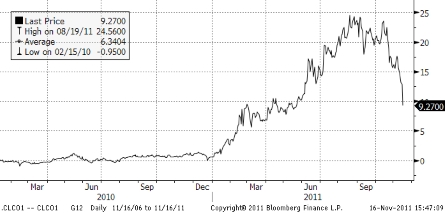The much followed but notoriously difficult to trade spread between US WTI crude and Brent crude saw the biggest collapse in weeks. Enbridge the US operator of the Seaway pipeline announced that it has agreed to reverse the direction of oil flows in order to enable it to transport oil from Cushing, the delivery hub for WTI, to refineries along the US Gulf Coast. Although this reverse flow of some 150,000 barrels per day, pending regulatory approval, will not commence until the second quarter of 2012 it caught traders' attention and WTI crude rallied as higher quantities will be flowing towards the coast where prices are closer to that of Brent Crude.
The spread has remained stubbornly high for months despite the storage levels at Cushing. The original explanation for the widening has been shrinking for many weeks thereby removing one of the reasons why US landlocked oil should be trading at a discount to the global market, represented by the price of Brent.
The narrowing of the spread is welcome news for the DJ UBS commodity fund. At the annual rebalancing in January 2012 it will add Brent crude to its basket of commodities while halving the exposure to WTI. This exercise will trigger a near $4 billion or 40 million barrels switch out of WTI into Brent and the recent collapse in the spread will benefit investors in the fund. Traders who have positioned themselves ahead of this trade have burnt their fingers and stop loss trades have probably helped the spread to narrow.
- English (UK)
- English (India)
- English (Canada)
- English (Australia)
- English (South Africa)
- English (Philippines)
- English (Nigeria)
- Deutsch
- Español (España)
- Español (México)
- Français
- Italiano
- Nederlands
- Português (Portugal)
- Polski
- Português (Brasil)
- Русский
- Türkçe
- العربية
- Ελληνικά
- Svenska
- Suomi
- עברית
- 日本語
- 한국어
- 简体中文
- 繁體中文
- Bahasa Indonesia
- Bahasa Melayu
- ไทย
- Tiếng Việt
- हिंदी
Brent WTI Crude Spread Collapses On Seaway Pipeline Reversal
Published 11/17/2011, 12:49 AM
Updated 03/19/2019, 04:00 AM
Brent WTI Crude Spread Collapses On Seaway Pipeline Reversal
Latest comments
Loading next article…
Install Our App
Risk Disclosure: Trading in financial instruments and/or cryptocurrencies involves high risks including the risk of losing some, or all, of your investment amount, and may not be suitable for all investors. Prices of cryptocurrencies are extremely volatile and may be affected by external factors such as financial, regulatory or political events. Trading on margin increases the financial risks.
Before deciding to trade in financial instrument or cryptocurrencies you should be fully informed of the risks and costs associated with trading the financial markets, carefully consider your investment objectives, level of experience, and risk appetite, and seek professional advice where needed.
Fusion Media would like to remind you that the data contained in this website is not necessarily real-time nor accurate. The data and prices on the website are not necessarily provided by any market or exchange, but may be provided by market makers, and so prices may not be accurate and may differ from the actual price at any given market, meaning prices are indicative and not appropriate for trading purposes. Fusion Media and any provider of the data contained in this website will not accept liability for any loss or damage as a result of your trading, or your reliance on the information contained within this website.
It is prohibited to use, store, reproduce, display, modify, transmit or distribute the data contained in this website without the explicit prior written permission of Fusion Media and/or the data provider. All intellectual property rights are reserved by the providers and/or the exchange providing the data contained in this website.
Fusion Media may be compensated by the advertisers that appear on the website, based on your interaction with the advertisements or advertisers.
Before deciding to trade in financial instrument or cryptocurrencies you should be fully informed of the risks and costs associated with trading the financial markets, carefully consider your investment objectives, level of experience, and risk appetite, and seek professional advice where needed.
Fusion Media would like to remind you that the data contained in this website is not necessarily real-time nor accurate. The data and prices on the website are not necessarily provided by any market or exchange, but may be provided by market makers, and so prices may not be accurate and may differ from the actual price at any given market, meaning prices are indicative and not appropriate for trading purposes. Fusion Media and any provider of the data contained in this website will not accept liability for any loss or damage as a result of your trading, or your reliance on the information contained within this website.
It is prohibited to use, store, reproduce, display, modify, transmit or distribute the data contained in this website without the explicit prior written permission of Fusion Media and/or the data provider. All intellectual property rights are reserved by the providers and/or the exchange providing the data contained in this website.
Fusion Media may be compensated by the advertisers that appear on the website, based on your interaction with the advertisements or advertisers.
© 2007-2025 - Fusion Media Limited. All Rights Reserved.
